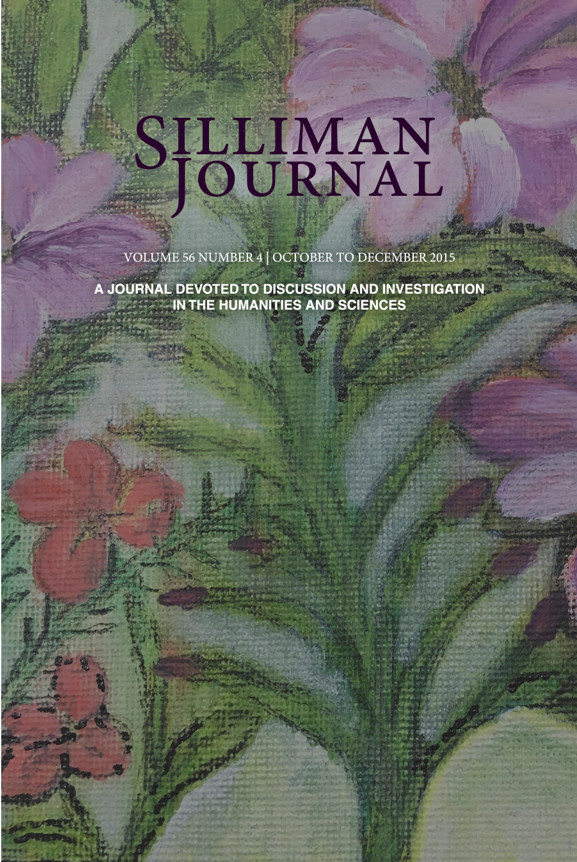Vol. 56 No. 4 (2015): Silliman Journal

Welcome to the fourth issue of Silliman Journal on its first year as a quarterly publication. SJ 2015 1 was also primarily a science issue and we end the year again with the studies of our colleagues from the natural and allied sciences. The first full-length article is one where biologists Robert Guino-o and his associates assessed the mariculture situation in Calape Bay, Central Philippines and found that, after three decades of mariculture activities, the Bay is threatened with organic pollution from internal and external sources. The authors recommend the establishment of a water monitoring system inside the bay the soonest possible time to regulate and maintain a healthy water quality standard for a sustainable aquatic ecosystem. In addition, still to be determined are the impacts of aquaculture-induced and river-carried sedimentation and organic matter on marine diversity and people’s fishing livelihood in and nearby Calape areas. Similarly, marine science researchers Iday Reboton and Nida Calumpong compare the coral reefs at two sites from each of three regions in the Philippines: Masbate in Region 5, Negros Oriental in Region 7, and Davao Oriental in Region 11. Coral cover has increased in Masbate and Negros Oriental while remaining the same in Davao Oriental (declining even at one site). In addition, the Apo Chapel (Negros Oriental) has the highest species diversity. Reef development was good in Apo Chapel and the sites in Davao Oriental. The authors discussed factors such as level of protection, exposure to natural and anthropogenic disturbances, and species composition that influence these changes. Then, Adel Caburian and company investigate the “Antimicrobial Activity of the Volatile Oil from the Leaves of Piper betle Linn.” This study of the betel leaf was rationalized on previous literature indicating that antimicrobials are one of our most important weapons in fighting bacterial and fungal infections, greatly benefiting the health-related quality of human life. However, over the past few decades, these health benefits have been under threat as many commonly used antibiotics have become less and less effective against certain illnesses not only because many of them produce toxic reactions, but also due to the emergence of drug-resistant bacteria. In the Philippines, the authors add, traditional medicine is one of the primary healthcare systems; plant extracts are widely claimed to have a broadspectrum antibacterial and are considered as a main source for the search of lead compounds.The results show active to very active inhibition of the bacterial and fungal growth against the test organisms, but the mechanism of its antimicrobial activity is not yet well understood. The fourth paper, entitled “Morphological and Thickness Characterization of Spin Coated Nafion Thin Films on Glass Substrate” by Shirley Tiong-Palisoc, Stephen Tadios, and Michelle Natividad, is a study of sensors. According to the authors, a sensor is a device designed to respond and detect a physical quantity and convert it to an observable output. Mercury is one example and the most commonly used because in addition to being resilient and very conductive, it is also highly sensitive and reproducible. It is, however, highly toxic. Alternatively, because of its low cost compared to other deposition techniques, spin coating was chosen as the method of fabricating Nafion thin films in this study.Results show that thickness of Nafion films decrease with increasing angular velocity and increase with increasing concentration. In a different context, psychologist Pierce Docena of the University of the Philippines in Tacloban, Leyte studies discharged youth offenders with crime desistance, looking particularly into their lives after rehabilitation. Docena interviewed ten male youth offenders in Eastern Visayas, finding that desistance from crime is a long and difficult process influenced by various factors such as family support, condition of one’s community, intervention of significant persons, having a job, getting married, and having children. Finally, physical therapy professors Reynaldo Ramos and Cyflor Putong investigate musculoskeletal disorders among teachers vis-a-vis the demands of their work. Not surprisingly, results indicated that teachers in the study are at risk to work-related musculoskeletal disorder because the nature of their work demanded them to assume a variety of postures and activities that may be perpetuated by an improperly designed workstation.

